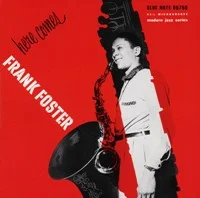Year: 1951
File: MP3@320K/s
Time: 73:52
Size: 170,1 MB
Art: Front
(3:43) 1. Bootsie
(3:08) 2. I Cover The Waterfront
(2:55) 3. Deep Purple
(4:37) 4. Lover Come Back To Me
(3:11) 5. That's My Desire
(3:12) 6. More Than You Know
(2:42) 7. Moody's Mode
(3:35) 8. This Is Always
(3:29) 9. Les Feuilles Mortes (Autumn Leaves)
(2:26) 10. Chanter Pour Toi
(2:49) 11. Bedelia
(2:41) 12. Aimer Comme Je T'aime
(2:28) 13. Si Jolie
(2:57) 14. September Serenade
(6:08) 15. My Heart Stood Still
(4:52) 16. Fat Shoes
(5:25) 17. I'll Take Romance
(4:44) 18. Escale A Victoria
(4:03) 19. The Things We Did Last Summer
(4:36) 20. Just 40 Bars
James Moody was an institution in jazz from the late '40s into the 21st century, whether on tenor, flute, occasional alto, or yodeling his way through his "Moody's Mood for Love." After serving in the Air Force (1943-1946), he joined Dizzy Gillespie's bebop orchestra and began a lifelong friendship with the trumpeter. Moody toured Europe with Gillespie and then stayed overseas for several years, working with Miles Davis, Max Roach, and top European players. His 1949 recording of "I'm in the Mood for Love" became a hit in 1952 under the title of "Moody's Mood for Love" with classic vocalese lyrics written by Eddie Jefferson and a best-selling recording by King Pleasure. After returning to the U.S., Moody formed a septet that lasted for five years, recorded extensively for Prestige and Argo, took up the flute, and then from 1963-1968, was a member of Dizzy Gillespie's quintet.
He worked in Las Vegas show bands during much of the 1970s before returning to jazz, playing occasionally with Gillespie, mostly working as a leader and recording with Lionel Hampton's Golden Men of Jazz. Moody, who alternated between tenor (which he preferred) and alto throughout his career, had an original sound on both horns. He was also one of the best flutists in jazz. Moody recorded as a leader for numerous labels, including Blue Note, Xanadu, Vogue, Prestige, EmArcy, Mercury, Argo, DJM, Milestone, Perception, MPS, Muse, Vanguard, and Novus. He died of complications from pancreatic cancer on December 9, 2010 in San Diego, CA. James Moody was 85 years old.~Scott Yanow https://www.allmusic.com/artist/james-moody-mn0000786080/biography
Personnel: Tenor Saxophone, Alto Saxophone – James Moody; Tenor Saxophone, Alto Saxophone – James Moody; Bass – Jean-Marie Ingrand, Pierre Michelot; Drums – Jean-Louis Viale, Pierre Lamarchand Drums, Strings, Woodwind – Pepito Riebe; Piano – Henri Renaud, Raymond Fol; Tenor Saxophone – Frank Foster; Trumpet – Roger Guérin
He worked in Las Vegas show bands during much of the 1970s before returning to jazz, playing occasionally with Gillespie, mostly working as a leader and recording with Lionel Hampton's Golden Men of Jazz. Moody, who alternated between tenor (which he preferred) and alto throughout his career, had an original sound on both horns. He was also one of the best flutists in jazz. Moody recorded as a leader for numerous labels, including Blue Note, Xanadu, Vogue, Prestige, EmArcy, Mercury, Argo, DJM, Milestone, Perception, MPS, Muse, Vanguard, and Novus. He died of complications from pancreatic cancer on December 9, 2010 in San Diego, CA. James Moody was 85 years old.~Scott Yanow https://www.allmusic.com/artist/james-moody-mn0000786080/biography
Personnel: Tenor Saxophone, Alto Saxophone – James Moody; Tenor Saxophone, Alto Saxophone – James Moody; Bass – Jean-Marie Ingrand, Pierre Michelot; Drums – Jean-Louis Viale, Pierre Lamarchand Drums, Strings, Woodwind – Pepito Riebe; Piano – Henri Renaud, Raymond Fol; Tenor Saxophone – Frank Foster; Trumpet – Roger Guérin
Sax Talk




















